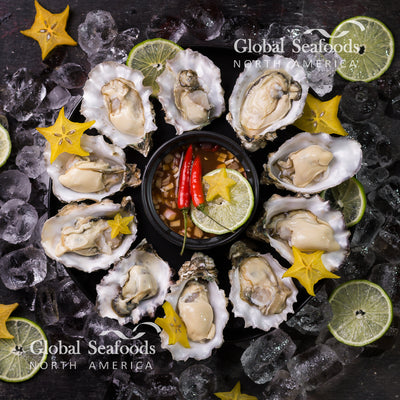Oyster Poaching: Techniques, Tips, and the Best Oysters for Your Table

Oyster Poaching: Techniques, Tips
Oyster poaching is an art that transforms raw oysters into tender, flavorful delights. Whether you're a seafood connoisseur or a home cook exploring new recipes, poaching oysters offers a delicate way to prepare this seafood favorite. In this guide, we’ll dive into the best techniques for poaching oysters, explore various oyster types, and share tips to create the most flavorful poached oyster dishes.
What is Oyster Poaching?
Poaching is a gentle cooking method that involves simmering oysters in liquid at low temperatures. This technique preserves the delicate texture and briny flavor of oysters while infusing them with the richness of the poaching liquid.
Why Poach Oysters?
- Enhance Flavor: Poaching allows you to infuse oysters with herbs, spices, and other seasonings.
- Preserve Texture: Gentle cooking prevents oysters from becoming rubbery.
- Versatile Preparation: Poached oysters can be served in soups, pasta, or as standalone appetizers.
Best Oyster Types for Poaching
Different oyster varieties offer unique flavors and textures, making them ideal for specific poaching recipes. Here’s a breakdown of some popular options:
1. Miyagi Oysters – Sweet and Creamy
- Flavor Profile: Mild sweetness with a creamy finish.
- Best for: Herb-infused poaching liquids with garlic and thyme.
- Suggested Recipe: Poached Miyagi oysters served on toasted baguettes with a lemon-butter drizzle.
2. Willapa Bay Oysters – Earthy and Briny
- Flavor Profile: Subtle earthiness with a clean, salty finish.
- Best for: Classic poaching liquids like white wine and shallots.
- Suggested Recipe: Willapa Bay oysters poached in white wine, topped with a dill cream sauce.
3. Tidepoint Oysters – Subtle and Smooth
- Flavor Profile: Lightly sweet with a delicate texture.
- Best for: Asian-inspired poaching liquids with soy, ginger, and scallions.
- Suggested Recipe: Poached Tidepoint oysters in miso broth, garnished with green onions.
4. Maine Oysters – Bold and Salty
- Flavor Profile: Robust salinity with a firm texture.
- Best for: Cream-based poaching liquids with heavy cream and spices.
- Suggested Recipe: Maine oysters poached in spiced cream, served over linguine.
5. Cliff Point Petite Oysters – Crisp and Refreshing
- Flavor Profile: Small and briny with a clean oceanic flavor.
- Best for: Citrus-based poaching liquids with lemon and orange zest.
- Suggested Recipe: Poached Cliff Point Petite oysters in citrus broth, served with a fennel salad.
Shop Cliff Point Petite Oysters
How to Poach Oysters: Step-by-Step Guide
Poaching oysters is simple with the right technique. Here’s how to do it:
Ingredients:
- 12 fresh oysters, shucked (Shop Fresh Oysters)
- 1 cup white wine or seafood stock
- 2 garlic cloves, minced
- 1 small shallot, finely chopped
- 1 sprig fresh thyme
- 1 tbsp butter
Instructions:
-
Prepare the Liquid:
- In a medium saucepan, combine white wine, garlic, shallots, thyme, and butter. Bring to a gentle simmer.
-
Add the Oysters:
- Carefully place the oysters into the poaching liquid. Ensure they’re submerged.
-
Poach Gently:
- Simmer for 2–3 minutes, or until the oysters curl slightly at the edges.
-
Remove and Serve:
- Using a slotted spoon, transfer the oysters to a serving dish. Spoon some poaching liquid over them or use it as a base for sauce.
Pro Tips for Poaching Oysters
- Use Fresh Oysters: For the best flavor, always use fresh, high-quality oysters from trusted sources like Global Seafoods.
- Don’t Overcook: Overcooking can make oysters tough. Watch for slight curling at the edges as a sign they’re ready.
- Experiment with Flavors: Try different poaching liquids, such as coconut milk for a tropical twist or tomato-based broths for bold flavor.
- Use the Liquid: Don’t discard the poaching liquid! It can be repurposed as a base for soups or sauces.
FAQs About Poaching Oysters
Q: Can I poach oysters with the shell on?
A: Yes, but shucking them first allows the poaching liquid to penetrate and enhances flavor.
Q: How do I store leftover poached oysters?
A: Store them in an airtight container in the refrigerator for up to two days. Reheat gently in the poaching liquid to retain their texture.
Q: Can I freeze poached oysters?
A: While it’s best to enjoy them fresh, you can freeze poached oysters for up to three months in a sealed container with their liquid.
Where to Buy Premium Oysters for Poaching
Get the freshest oysters for poaching from Global Seafoods:
YouTube Channel Link:
Learn more about poaching oysters and other seafood recipes on the Global Seafoods YouTube Channel.
Conclusion
Poaching oysters is a simple yet elegant way to enjoy this seafood delicacy. By pairing the right oyster variety with complementary poaching liquids, you can elevate the flavors and create a memorable dining experience. Whether you’re a seasoned oyster lover or a beginner, poaching is a technique that’s worth mastering.
Order your fresh oysters from Global Seafoods today and try these recipes to explore the art of oyster poaching!
Also in News

How to Make Sea Bream Sushi With Dry-Aged Tuna & Crab Roll — Step-by-Step With Chef Joshua
A complete guide to making Sea Bream sushi at home, including filleting, curing, slicing, and building a Dry-Aged Tuna & Crab sushi roll. Chef Joshua shares professional tips for restaurant-quality results.

Boiled Crab for Game Night: Everything You Need for a Perfect Seafood Party
Take your game night to the next level with a Boiled crab party. Learn the best recipes, cooking tips, and hosting hacks for a memorable seafood feast.

Boiled Crab for Date Night: A Romantic Guide to the Perfect Seafood Feast
Make your next date night unforgettable with a romantic Boiled crab experience. This guide covers everything you need to know, from ambiance to the best crab varieties.






